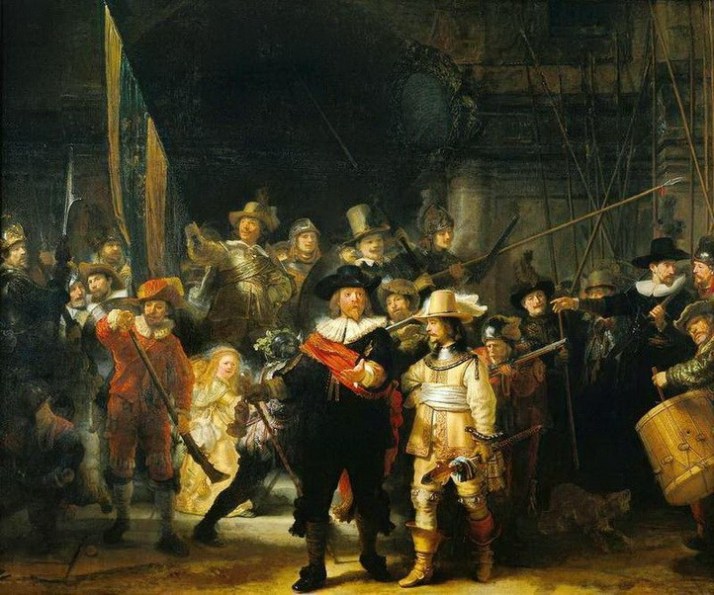Art, Security and Everything In Between In 1642 Rembrandt drew the “Night Watch”, a painting that he was commissioned to draw by a group of noblemen that had volunteered to safeguard the city at night.

The full name of the painting is “The Militia Company of District II under the Command of Captain Frans Banninck Cocq. It depicts the 13th Company of the Civil Guard headed by Captain Cocq (who is dressed in black and red) and his deputy – Lieutenant Willem Van Rytenburch.
Rembrandt’s painting is different from other paintings of the militia that were common in Amsterdam at the time, in which all members of the militia sat or stood in a line, with their faces clearly visible. In contrast, there is a lot of movement in Rembrandt’s painting, with some of the militia members even hidden from full view, which was a cause of distress for some of them, leading to the painting being hung in In 1642 Rembrandt drew the “Night Watch“, a painting that he was commissioned to draw by a group of noblemen that had volunteered to safeguard the city at night.
The residents of Amsterdam that are portrayed in the painting, including a girl in a yellow dress, are shown hailing the militia guards as they are about to embark on a mission to protect the city.
The presence of residents of Amsterdam in the painting would seem to indicate that the mission of the militia guards was not to protect the city from a foreign enemy but rather from more domestic criminal activity, which was most likely the main reason for the establishment of the Banninck Cocq militia.
As noted above, the painting is called the Night Watch, and in numerous articles that have been written in English about the painting – the members of the militia are termed “security guards”.
It would seem that the need to protect a city’s residents is not a phenomenon that is unique to the 20th century. Issues related to a “safe city” or “a city without violence” have been the concern of local leadership of large cities and their residents since the onset of the Modern Age. Furthermore, the fact that the members of the militia volunteered to protect the city might indicate that, as in our times – local forces, for whatever reasons, were not able to provide adequate civilian protection services, leading to the formation of groups from within the population to carry out these services instead.
It would appear that Rembrandt’s methodology for planning the painting placed emphasis on displaying operational movement of the force/militia rather than merely settling for a group picture.
It can therefore be concluded that the phenomenon of dealing with issues related to public security is by no means new. For many years police and law enforcement agencies have constituted the governmental mechanism for maintaining civil security. The addition of terror to the list of threats against civilians of a country in general, and of cities in particular, has led to a gap in their ability to provide satisfactory solutions since the police, who are typically trained to deal with crime and public order, lack the ability to provide an adequate security response due to lack of knowhow and lack of an integrated security concept. The need to provide rapid and effective responses has led community leaders to commission private companies that consist of ex-military and policemen no longer in active duty.
However as talented as they may be, and even though they often have experience in similar or interfacing areas – this experience is not appropriate or applicable for dealing with the vast array of challenges that constitute the discipline of public security, which covers numerous civilian, legal and ethical issues that are significantly different than the issues typical of military and conventional police work.
The understanding that security is a unique discipline that is unlike other public order disciplines, and the recognition that the people whose job it is to protect the public from a wide variety of threats that risk the public’s freedom as well as its property require specialized training, has led veteran security officers to try and come up with ways to deal with the problem.
To this end, a team was put together to try and formalize the security profession and establish clear guidelines, so that only professionals with proven security experience in the various security-related areas pertaining to national security in general, and public security in particular, will be able to practice in the field of providing security related services, which include consultancy, planning and accompaniment of security frameworks.
The team consists of veteran security agents and consultants, and its objective is to determine a professional, binding “standard” for all people actively involved in providing security-related services.
Any person who sees himself as being able and/or wanting to contribute is more than welcome to bring his insights before the committee. I am sure that the day is not far off when the area of security will be led by top-notch professionals, just as the military, police and security forces are led by professionals in their respective fields.

